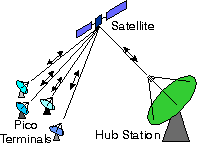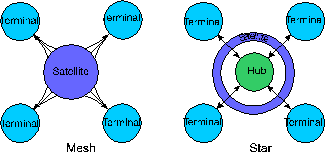
Very Small Aperture Terminal (VSAT)
Communication systems increasingly offer the possibility to communicate to somebody
anywhere and anytime. In telephony, this becomes evident by the development of
cellular telephone networks. Proposals, such as Iridium exist for a global network in which
handheld telephones directly have access to low-Earth-orbit (LEO) satellites.
Satellite data communication systems show a similar development as telephone
systems. The tendency here is towards smaller and transportable groundstations. This
is shown by the popularity of the very small aperture terminals (VSATs) in the United
States of America. VSATs are small satellite groundstations, normally linked within a
VSAT network. The size of a VSAT is limited to a maximum antenna diameter of
approximately 240 cm. VSATs are suitable for low rate data traffic (approximately 64
kbit/s).
VSAT Applications
Due to the small bit
rate on the return link, the system is especially suitable for data collection applications.
Suppose the system is divided into smaller subsystems, each with its own hub station.
These subsystems could for example be used for national weather data collection.
The complete system could also be used for international data collection. In principle,
with three geostationary satellites, a global coverage is possible. In this way it is
possible to collect (weather) data for, for example, global climate (change) research.
VSAT Network
VSAT networks consist of a number of terminals and a satellite through which the
terminals communicate. Usually a bigger groundstation, often called a "hub station", is
added for network control. If it is not possible to transfer messages directly from one
VSAT to another, the hub can also be used as an intermediate station. VSAT
networks have a number of advantages over traditional terrestrial networks. Among
these advantages are that VSAT networks can easily cover a wide geographical area
and that it is relatively easy to change the network configuration.

Figure: VSAT network
Through the development of powerful satellites operating in the 30/20 GHz frequency
bands it is possible to further reduce the size of VSATs. Ultra-small fully portable
satellite groundstations (picoterminals) with an antenna diameter of approximately
10-20 cm are possible in principle. However these terminals will have a very low data
rate of a few kbit/s or even lower. So their primary purpose lies in telex-like message
transfer, although technically it is possible to use them for coded speech transfer (for
example 4.8 kbit/s).
Multiple Access
One satellite can simultaneously support thousands of picoterminal accesses. This
means that the number of users in a picoterminal network can be a multiple of this,
resulting in a communication network with an enormous size. To control such a
number of terminals, the multiple access scheme for picoterminals may be a
combination of frequency division multiple access (FDMA)
and code division multiple access
(CDMA).
The CDMA spread-spectrum technique normally used for satellite communications is
direct sequence spread spectrum.
The use of spread spectrum techniques in picoterminal networks has several
advantages.
- It is advantageous as multiple access scheme, because (asynchronous)
SSMA does not need network control and synchronisation.
- A second advantage is the
inherent interference protection of the system. This is important for picoterminals
which will be more or less sensitive to interference from unwanted directions due to
their small antennas.
- A third advantage is that picoterminals can transmit with low
power densities giving less interference problems.
- Finally SSMA gives some kind of
message privacy through the encryption with a code word.
Picoterminal satellite communications network

Figure: Mesh and star VSAT network architectures
Two basic architectures for a picoterminal satellite communications network exist.
These are the full mesh architecture and the star architecture. In a full mesh
architecture a terminal can directly communicate with another terminal via the satellite.
In a star network communication between two picoterminals is via a larger hub station.
The CODE system
The (Co-operative Olympus Data Experiment) CODE
system, which operates at Ka band, consists of a large number of
microterminals with 80 cm diameter antennas which can communicate directly in a
mesh network at 64 kbit/s. A central hub station is used for channel allocation, general
monitoring and control of the microterminals. The CODE system uses the 30/20 GHz
transponder of the Olympus satellite. The satellite access scheme of the system is
FDMA (Frequency Division Multiple Access) with two types of signals: 2 Mbit/s QPSK
and 64 kbit/s BPSK, both 1/2-rate FEC encoded. The 2 Mbit/s QPSK signals originate
from the hub station. The 64 kbit/s BPSK signals are generated by the microterminals.
The total bandwidth of the Olympus 20/30 GHz transponder of 40 MHz can
accommodate a total of four 2 Mbit/s carriers together with up to one hundred 64
kbit/s carriers.
As the CODE network is a full mesh network a microterminal can directly
communicate with another microterminal via the satellite.







